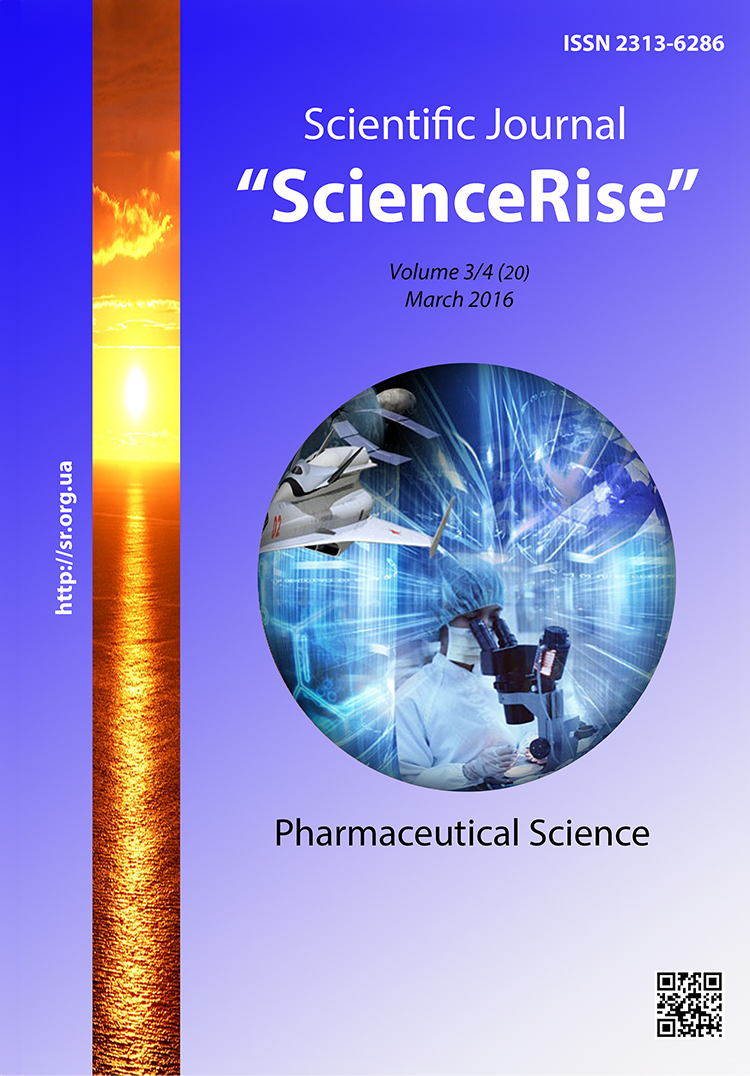Розробка та валідація тесту «розчинення» для таблеток рибоксин
DOI:
https://doi.org/10.15587/2313-8416.2016.64504Słowa kluczowe:
рибоксин, розчинення, абсорбційна спектрофотометрія в ультрафіолетовій та видимій області, таблеткиAbstrakt
В умовах інтенсивного розвитку фармацевтичної промисловості і розмаїття препаратів для перорального прийому, у фахівців виникає необхідність оновлювати свої знання о лікарських засобах цієї категорії і процесах, що відбуваються в організмі при їх всмоктуванні. З метою збільшення біодоступності лікарських речовин та зменшення небажаних фармакологічних ефектів, для таблетованих лікарських форм введений тест розчинення.
Мета. Метою наших досліджень є розробка та валідація методики тесту розчинення таблеток, що містять як діючу речовину рибоксин, який має метаболічну, антигіпоксичну та антиаритмічну дію та останнім часом виготовляється фармацевтичними підприємствами України.
Методи. Тест розчинення проводили на приладі для визначення розчинності таблеток ERWEKA DT 806 HH. Аналітичні дослідження проводили методом спектрофотометрії на спектрофотометрі Specord 205 фірми «Analytik Jena AG» (Германия), з використанням ваг лабораторних електронних OHAUS AP 250D фірми «Ohaus Corporation» (США) та мірного посуду класу А.
Результати. У результаті дослідження обрано середовище розчинення – вода, об’єм середовища, концентрація діючої речовини та час проведення випробування – 45 хвилин. Кількість рибоксину, що перейшла у розчин, запропоновано визначати методом абсорбційної спектрофотометрії в ультрафіолетовій та видимій області за довжини хвилі 249 нм методом стандарту.
Для запропонованої методики вивчені валідаційні характеристики відповідно вимогам ДФУ за такими параметрами як специфічність, лінійність, прецизійність (збіжність), правильність, діапазон застосування. Встановлено, що валідаційні характеристики методики не перевищують критичного значення похибки (3,0 %).
Висновки. У результаті проведених експериментальних досліджень розроблено та валідовано спектрофотометричну методику кількісного визначення рибоксину після проведення фармако-технологічного випробування розчинення. Запропоновано середовище розчинення, його об’єм, час проведення та кількість таблеток для випробування
Bibliografia
Peart, J., Flood, A., Linden, J., Matherne, G. P., Headrick, J. P. (2002). Adenosine-Mediated Cardioprotection in Ischemic-Reperfused Mouse Heart. Journal of Cardiovascular Pharmacology, 39 (1), 117–129. doi: 10.1097/00005344-200201000-00013
Peart, J., Willems, L., Headrick, J. P. (2002). Receptor and non-receptor-dependent mechanisms of cardioprotection with adenosine. American Journal of Physiology – Heart and Circulatory Physiology, 284 (2), H519–H527. doi: 10.1152/ajpheart.00717.2002
Peart, J. N., Gross, G. J. (2003). Adenosine and opioid receptor-mediated cardioprotection in the rat: evidence for cross-talk between receptors. American Journal of Physiology – Heart and Circulatory Physiology, 285 (1), H81–H89. doi: 10.1152/ajpheart.00985.2002
Kursov, S. V., Nikonov, V. V., Hyzhnjak, A. A. et. al (2013). Osoblyvosti gemodynamichnyh efektiv inozytu (korotkyj literaturnyj ogljad za rezul'tatamy vlasnyh sposterezhen'. Medycyna neotlozhnыh sostojanyj, 1 (48), 86–92.
Dachir, S., Shabashov, D., Trembovler, V., Alexandrovich, A. G., Benowitz, L. I., Shohami, E. (2014). Inosine improves functional recovery after experimental traumatic brain injury. Brain Research, 1555, 78–88. doi: 10.1016/j.brainres.2014.01.044
Zai, L., Ferrari, C., Dice, C., Subbaiah, S., Havton, L. A., Coppola, G. et. al (2011). Inosine Augments the Effects of a Nogo Receptor Blocker and of Environmental Enrichment to Restore Skilled Forelimb Use after Stroke. Journal of Neuroscience, 31 (16), 5977–5988. doi: 10.1523/jneurosci.4498-10.2011
Derzhavna Farmakopeja Ukrai'ny. Vol. 1 (2015). Kharkiv: Derzhavne pidpryjemstvo «Ukrai'ns'kyj naukovyj farmakopejnyj centr jakosti likars'kyh zasobiv», 1128.
Kitajs'ka farmakopeja. Vol. 2 (2005). People's Medical Publishing House, 438–440.
Gosudarstvennaja farmakopeja Rossijskoj Federacii. Chep. 1 (2007). Nauchnyj centr jekspertizy sredstv medicinskogo primenenija. RIBOKSIN (FS 42-0275-07), 624–627.
Chitta, R., Pendela, M., Yekkala, R., Herijgers, P., Hoogmartens, J., Adams, E. (2010). Determination of Adenosine and Inosine in Sheep Plasma Using Solid Phase Extraction Followed by Liquid Chromatography with UV Detection. Analytical Letters, 43 (14), 2267–2274. doi: 10.1080/00032711003717323
Rosada, M. V., Bevz, N. Ju., Georgijanc, V. A. (2015). Rozrobka ta validacija metodyky kil'kisnogo vyznachennja ryboksynu v tabletkah. Upravlinnja, ekonomika ta zabezpechennja jakosti v farmacii', 5 (43), 21–26.
Rosada, M. V., Bevz, N. Yu., Garna, N. V., Georgiyants, V. A. (2016). The study of dissolution kinetics of drugs with riboxinum (inosine). Der Pharma Chemica., 8 (1), 412–416. Available at: http://derpharmachemica.com/vol8-iss1/DPC-2016-8-1-412-416.pdf
##submission.downloads##
Opublikowane
Numer
Dział
Licencja
Copyright (c) 2016 Микола Володимирович Росада, Наталія Юріївна Бевз, Вікторія Акопівна Георгіянц

Utwór dostępny jest na licencji Creative Commons Uznanie autorstwa 4.0 Międzynarodowe.
Our journal abides by the Creative Commons CC BY copyright rights and permissions for open access journals.
Authors, who are published in this journal, agree to the following conditions:
1. The authors reserve the right to authorship of the work and pass the first publication right of this work to the journal under the terms of a Creative Commons CC BY, which allows others to freely distribute the published research with the obligatory reference to the authors of the original work and the first publication of the work in this journal.
2. The authors have the right to conclude separate supplement agreements that relate to non-exclusive work distribution in the form in which it has been published by the journal (for example, to upload the work to the online storage of the journal or publish it as part of a monograph), provided that the reference to the first publication of the work in this journal is included.

